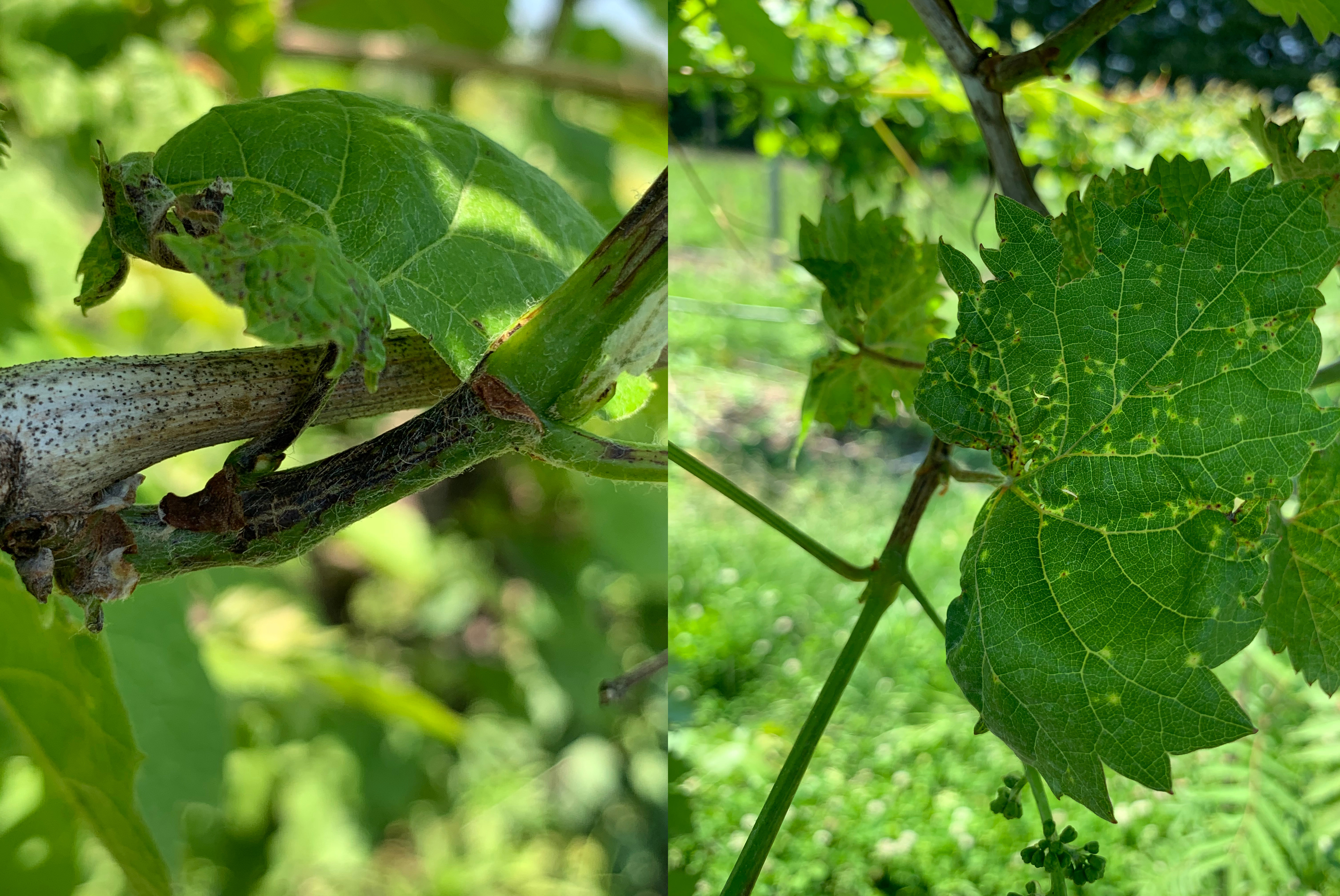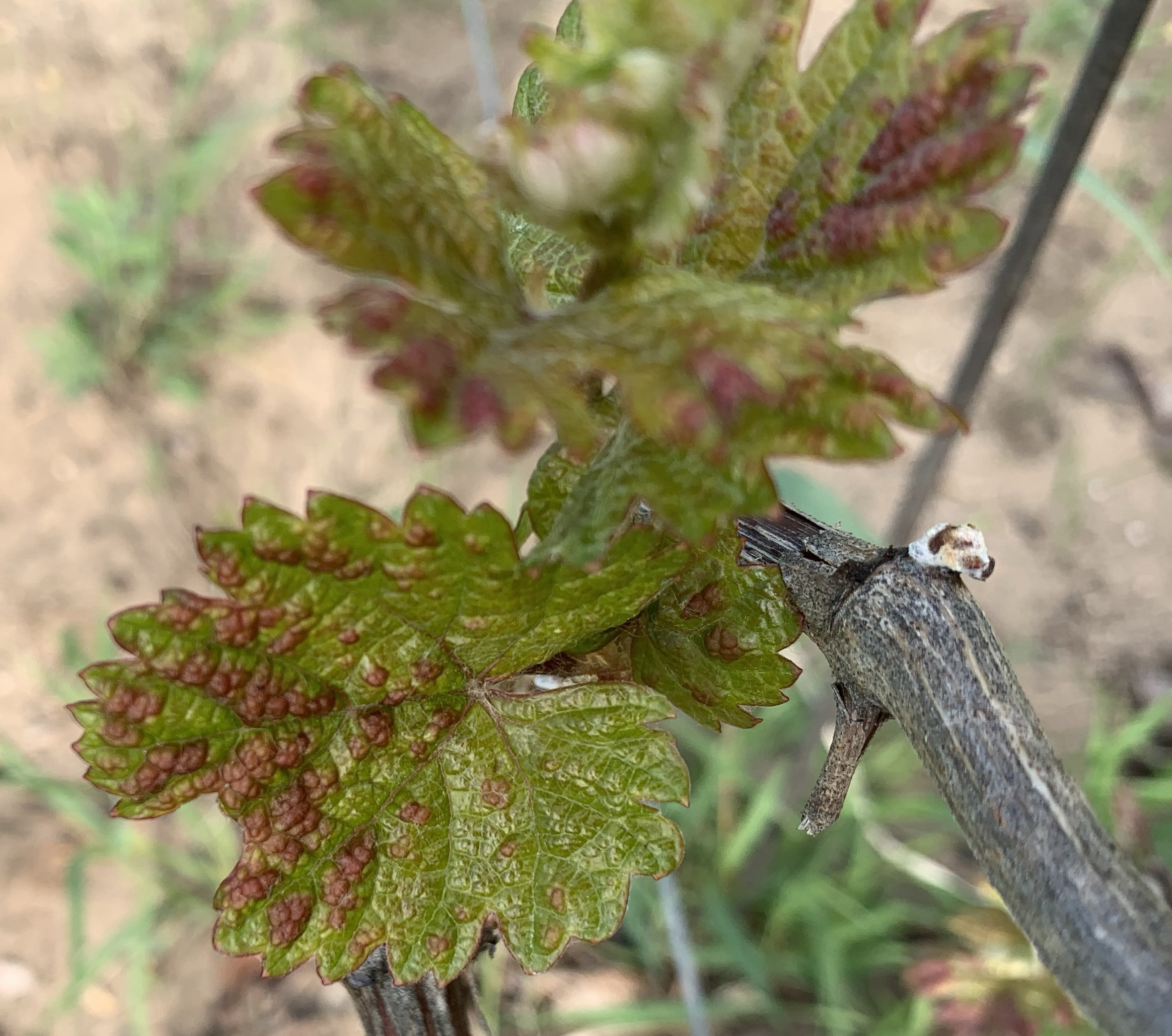Michigan grape scouting report – June 3, 2020
The warm, wet weather means disease management is critical now. Prebloom webinar this Thursday, June 4.

Weather
Last week started hot. All grape growing regions throughout Michigan saw highs in the 80s and 90s over the weekend and start of the week. Lows were in the 60s. Rain came with the heat in the northern region and continued through much of the week. For the southern part of the state, the rain accompanied the cooler temperatures that came on Wednesday and Thursday, May 27 and 28. This resulted in quite a range of precipitation amounts. Much of the northern grape growing region saw up to 2 inches. The southern parts of the state largely saw a half-inch or less.
The remainder of this week will see highs near 80 dropping to around 70 by the weekend for much of the state, with a return to the 80s to start next week. There are chances of showers, but no heavy rain events are expected.
With the warm week, vineyards throughout the state picked up quite a few growing degree days (GDD), 110-130 GDD base 42, and 70-110 GDD base 50. The southwest region is 280 GDD base 42 and 165 GDD base 50 ahead of the northwest region.
|
Northwest Michigan GDD summary from March 1 - June 1, 2020 | |||
|---|---|---|---|
|
Northwest stations |
GDD 42 F |
GDD 45 F |
GDD 50 F |
|
Petoskey (Petoskey) |
419 |
322 |
198 |
|
Traverse City (NWMHRC) |
460 |
354 |
218 |
|
Old Mission (Old Mission) |
429 |
327 |
198 |
|
Average for the NW region |
459 |
353 |
218 |
|
Average last week |
349 |
260 |
150 |
|
Southwest Michigan GDD summary from March 1 - June 1, 2020 and southeast Michigan GDD summary from March 1 - June 1, 2020 | |||
|---|---|---|---|
|
South region stations |
GDD 42 F |
GDD 45 F |
GDD 50 F |
|
Benton Harbor (SWMREC) |
741 |
591 |
388 |
|
Lawton (Lawton) |
743 |
590 |
383 |
|
Fennville (TNRC) |
660 |
518 |
326 |
|
Average for the SW region |
739 |
588 |
384 |
|
Average last week |
607 |
473 |
297 |
|
Romeo (Romeo) |
663 |
518 |
326 |
|
Average for the SE region |
685 |
537 |
342 |
|
Average last week |
550 |
420 |
252 |
Vine growth
Juice grapes in much of southern Michigan have up to 18 inches of growth. Clusters are starting to elongate and open. Most Vitis vinifera cultivars are at 6-12 inches of growth. Wild grape is significantly further along with clusters separating. In Berrien County, bloom has been seen in wild grape in some areas near Lake Michigan but is further behind in many parts of Berrien and Van Buren counties. The extreme variability in bloom dates this year emphasizes the need to scout around your fields to determine the bloom date for your farm.
In northern vineyards, shoots are at 2-6 inch of growth, depending on variety. See this chart for grape growth stages.
Diseases
Early season disease management in vineyards is critical. The first few applications until three weeks post-bloom are the most important. If shoots are more than 3 inches long, focus on black rot and phomopsis management. Multisite products in the ethylene bisdithiocarbamate (EBDC) group (e.g., Manzate) are a great option for these diseases at this time of year. EBDCs provide good to excellent control and do not increase the development of fungicide resistance. They will not cure established infections.
In areas where clusters are emerging and grapes are growing quickly, fungicide sprays for grape black rot, phomopsis and powdery mildew are vital. Warm, wet weather promotes this quick growth and increases chances of infection. There have been multiple wetting periods with enough leaf wetness for phomopsis infections to take hold. Starting this week, we have seen phomopsis damage on canes and leaves in grapes in Van Buren and Berrien counties.
As bloom approaches, start choosing fungicides that control all the fruit diseases. These include downy mildew, phomopsis, powdery mildew and black rot. These diseases all infect new green tissue as it is exposed. For an overview on the general diseases and management options, see “Early season vineyard disease management” and the importance of bloom applications.

Insects
Note: Thorough scouting should be done before assuming insects are an economic problem.
For southern Michigan grape growers, insect pests to be on the lookout for at this time are rose chafer and potato leafhopper. Rose chafers can be found feeding on clusters. Potato leafhoppers feed on leaves. The leaves of some sensitive grape varieties can be yellowed and cupped in response to leafhopper feeding. Most vines are very tolerant of their damage and control isn’t warranted. Treatment recommendations for both of these insects can be found in the Michigan State University Extension Fruit Pest Management Guide (E0154).
First reports of tumid gallmaker symptoms have been seen in hybrids this week. For small vineyards, hand picking and removal of infestations can be an effective management technique. Foliar infestations of grape phylloxera have also been reported. Vines can withstand a lot of leaf damage. If there is a high infestation or if clusters are affected, Movento is an effective insecticide for both of these pests. This should be applied at the first sign of infestation. Movento needs to penetrate the waxy leaf surface, so application with a penetrating adjuvant is essential to get control.
Grape Erinium mite has been observed on young leaves at a few vineyards in the Traverse City, Michigan, area. These rarely reach economic infestation levels but can be confused with disease symptoms.

Upcoming meetings
Our grower meetings have moved online. We are using Zoom for our meetings. Here is more information on Zoom. You need to register for these meetings. Do not expect to be able to join these meetings just before they start. These meetings will be closed and many are password protected to prevent their disruption by others.
- The Grape Prebloom Webinar will be Thursday, June 4, from 1-4 p.m. You can see the agenda and register online.
Related articles
- A Mobile Guide for Grape IPM Scouting in North Central and Eastern U.S.
- Managing grapevine leafroll disease
- Michigan pesticide applicators receive temporary emergency license extension
- Online review now available for private pesticide applicators
- Weekly fruit IPM meetings start April 13 and are now online
- Agriculture support labs still open for business, with modifications
- Early season vineyard disease management
- Disease control in grapes critical during and after bloom



 Print
Print Email
Email